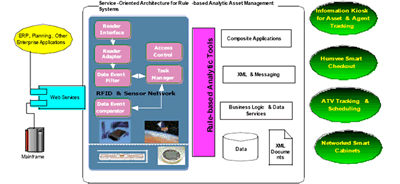Information Architectures for Human Space Exploration
One of the major difficulties in mission planning for interplanetary human space exploration is information management. The International Space Station (ISS) program, for example, has experienced difficulties predicting spares requirements, tracking tools and equipment, and even shipping appropriate amounts of crew provisions, all due to a lack of correct information. These difficulties are predicted to be significantly compounded for programs that venture outside Earth orbit, where the complexity of sending on-demand shipments is even greater. It seems clear from this experience that sustainable space exploration operations are not possible without appropriate information architectures.
A related project explores the role of web-based services, radio frequency identification (RFID) and smart containers as an enabler of real-time asset management and tracking:

Space agencies around the world are gearing up for new human space exploration missions. In order to ensure that such programs are sustainable, it is worthwhile to examine the lessons learned in past experience with space logistics and supply chain management. This project has done an analysis of the current state of the art in information management for space exploration, and highlights some of the key technologies that have the potential to significantly improve the performance of space logistics systems.
Current State of the Art
The current state of the art in asset tracking for space exploration relies on a barcode based system interfacing with an Inventory Management System (IMS) database. Using a barcode based system for inventory management is very labor intensive and occasionally an update is missed and an item's status becomes unknown. On average 3% of the items in the IMS database are listed as "lost", meaning that the item was not in the location that it was showing in IMS the last time the crew looked for it. If a critical item is listed as lost, the mission control team has to decide whether to allocate critical crew time to continue looking for the item or, if there is a spare on the ground, to launch a replacement on an upcoming mission; both of these options are very costly. A barcode based system is also extremely time-consuming for both the crew and ground personnel. The ISS crew is allotted 20 minutes every day to make updates to the IMS system but in reality a much larger portion of their day is dedicated to this task.
Innovative Technologies
As humans plan for a return to the moon and travel on to Mars, innovative technologies should be utilized to improve upon current methods of interplanetary supply chain management. One of these emerging technologies is radio frequency identification (RFID). RFID has been around since the 1970's but is only recently becoming a "buzz word". The recent interest in RFID stems from several factors: one is the post-9/11 interest in using RFID for homeland security purposes; another is mandates from large commercial product retailers that suppliers must start using RFID at the pallet level to help automate inventory management. RFID shows great promise in space exploration to allow nearly autonomous tracking of commodities and passing of information.
For future lunar and Mars bases, it is envisioned that information collected from a network of RFID sensors will be combined with mathematical models and rule-based analysis to produce meaningful data for asset tracking and intelligent decisions. The figure above illustrates such a network, comprised of a Service-Oriented Architecture (SOA) with Rule-based Analytic Tools interacting with RFID systems and sensor networks.
